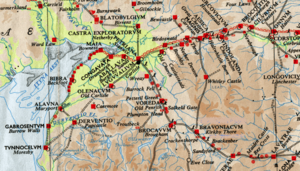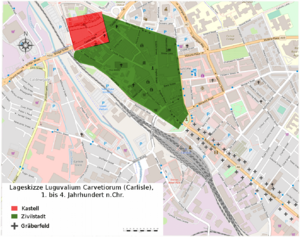Luguvalium facts for kids
Luguvalium was an ancient Roman city in northern Britain. Today, it's known as Carlisle in Cumbria. This city might have been the capital of a Roman area called Valentia in the 300s AD. It was also the most northern city in the entire Roman Empire!
Contents
Where Was Luguvalium Located?
Luguvalium was built in a very important spot. It was at a crossroads where major Roman roads met, going north-south and east-west. The city was also close to the Roman border, which was first marked by the Stanegate road and later by Hadrian's Wall.
Because of its location, Luguvalium became a key place for supplies, soldiers, and trade. It also protected an important area where the River Caldew and River Eden met. This made it a great spot for controlling trade routes.
Today, most of the old Roman city is under modern Carlisle. However, the Roman fort, which the city grew around, is mostly under Carlisle Castle.
What Does the Name Luguvalium Mean?
The Romans called this settlement Luguvalium. This name came from an older British word, *Luguwalion. It meant "city of Luguwalos." Luguwalos was a Celtic man's name, meaning "strength of Lugus" (a Celtic god).
The name continued to be used by people speaking British languages in northern England and Wales. Later, the word caer (meaning "fort") was added to it. In old Welsh writings, it was called Cair Ligualid or Caer Liwelyδ. This is why modern Carlisle is called Caerliwelydd in Welsh.
The earliest English record of the place is from around 1050, as Luel. Later, it was called Cardeol or Karlioli.
History of Roman Luguvalium
Early Settlements in the Area
Before the Romans arrived, there were not many signs of large settlements in this area during the British Iron Age. The main city for the local Carvetii tribe seemed to be Clifton Dykes.
The Roman Era Begins
After conquering southern Britain, the Roman armies moved north. Around 72 AD, they built a wooden fort. It was placed at a key point south of the River Eden, in a loop protected by water on two sides. This was the site where Carlisle Castle would later stand.
This fort became the center of the important Roman town of Luguvalium. A part of the Legio IX Hispana (Ninth Legion) built this fort. They were fighting against the Brigantian tribe at the time.
The fort was updated in 83 AD using strong oak wood. This showed that the Romans had more control over the area. A cavalry (horse-riding soldier) group of 500, called the Ala Gallorum Sebosiana, was stationed there.
Around 87 AD, the "Stanegate" frontier was set up. This line of forts, including Luguvalium, stretched east to Corbridge. It was a more stable border against the Picts (people from Scotland) than earlier borders. By the early 100s AD, Carlisle was a strong Roman base. The fort was taken down around 103 AD but rebuilt before 105 AD. It kept its soldiers until the time of Emperor Hadrian.
Hadrian's Wall and Changes
In 122 AD, Emperor Hadrian visited the area. He approved a plan to build a large wall, Hadrian's Wall, slightly north of the Stanegate. A new, very large fort called Uxelodunum was built on the wall in the Stanwix area of Carlisle. This fort became the biggest along Hadrian's Wall. It housed a cavalry group of 1,000 soldiers, the Ala Gallorum Petriana.
The Luguvalium fort slowly had fewer soldiers from 105 AD. It was finally taken down and left empty between 138 and 161 AD. However, it was rebuilt with stone around 200 AD by the Legio XX Valeria Victrix (Twentieth Legion) from York. The fort was finally left for good sometime between 275 and 325 AD.
Life in the Civilian Town
A civilian settlement, called a vicus, grew up outside the fort. This settlement probably became the main town for the Carvetii tribe in the 100s AD. Eventually, a stone wall was built around it.
People in the town worked with copper and made leather (tanning). There were also many merchants. Inscriptions found show that there was a Mithraeum (a temple for the god Mithras) and possibly a temple for the Roman god Mars. Mars was linked to a local Celtic god called Belatucadros.
Roman coins found in the area suggest that Romans stayed in Carlisle until the time of Emperor Valentinian II, from 375 to 392 AD.
After the Romans Left
People continued to live in Luguvalium even after the Romans officially left Britain around 410 AD. Some buildings from the 400s have been found. The settlement might have been the home of King Urien Rheged.
In the 600s, Saint Cuthbert visited the town. He described its tall stone walls and a wonderful fountain. This fountain was likely fed by an aqueduct (a water channel) that was still working!
Discoveries and Excavations
Archaeologists have done many digs in Carlisle. In the 1950s, they found the site of the Luguvalium fort. It's south of the medieval Carlisle Castle, which sits over the fort's northeast corner. More recent digs have uncovered well-preserved wooden parts of the Roman gatehouse and its wall.
Large Roman marching camps have been found near Carlisle. These camps were used by Roman soldiers on the move. Tiles and pottery with stamps from the Legio IX Hispana have been found south of Carlisle. This shows that parts of this famous Ninth Legion were involved in the early Roman presence here.
Between 1981 and 1990, about 50 wooden writing tablets were found inside the Roman fort. These tablets are very important, second only to those found at Vindolanda. They give unique information about the cavalry group, the ala Gallorum Sebosiana, and what they ate (barley, wheat) and used (weapons).
In 2017, very large Roman baths were discovered north of the River Eden. These baths were bigger than any found near Hadrian's Wall! They might have belonged to a mansio, which was like a Roman hotel for travelers.
In 2021, more discoveries suggested that Roman Emperor Septimius Severus and his wife Julia Domna might have spent time in Luguvalium around 208-211 AD. Engraved stone pieces dedicated to the empress were found. Also, tiles stamped with the emperor's personal workshop mark were discovered. Severus was campaigning in Scotland at that time. In 2023, two oversized sculptures of heads were also found!




